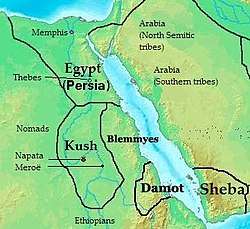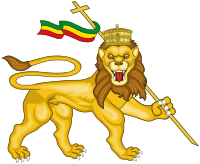Dʿmt
| Dʿmt ደዐመተ | |||||||
|---|---|---|---|---|---|---|---|
| c. 980 BC–c. 400 BC | |||||||
 | |||||||
| Capital | Yeha (Likely)[1] | ||||||
| Common languages | Ge'ez,Other South Semitic languages | ||||||
| Religion | Traditional African religions | ||||||
| Government | Monarchy | ||||||
| Historical era | Iron Age | ||||||
• Established | c. 980 BC | ||||||
• Disestablished | c. 400 BC | ||||||
| |||||||
Dʿmt (South Arabian alphabet : ![]()
Part of a series on the |
|---|
| History of Eritrea |
| Pre-colonial |
| Colonial |
| Post-colonial |
| State of Eritrea |
|
|
Part of a series on the |
||||||||||||||||||||||
|---|---|---|---|---|---|---|---|---|---|---|---|---|---|---|---|---|---|---|---|---|---|---|
| History of Ethiopia | ||||||||||||||||||||||
 | ||||||||||||||||||||||
|
Early history
|
||||||||||||||||||||||
|
Middle Ages
|
||||||||||||||||||||||
|
Early modern history
|
||||||||||||||||||||||
|
Modern history
|
||||||||||||||||||||||
|
Recent history
|
||||||||||||||||||||||
|
Topics |
||||||||||||||||||||||
|
| ||||||||||||||||||||||
History
Given the presence of a large temple complex and fertile surroundings, the capital of Dʿmt may have been present day Yeha, in Tigray, Ethiopia.[1] At Yeha the temple to the god Ilmuqah is still standing.[5]
The kingdom developed irrigation schemes, used plows, grew millet, and made iron tools and weapons.
Some modern historians including Stuart Munro-Hay, Rodolfo Fattovich, Ayele Bekerie, Cain Felder, and Ephraim Isaac consider this civilization to be indigenous, although Sabaean-influenced due to the latter's dominance of the Red Sea, while others like Joseph Michels, Henri de Contenson, Tekle-Tsadik Mekouria, and Stanley Burstein have viewed Dʿmt as the result of a mixture of Sabaeans and indigenous peoples.[6][7] The most recent research, however, shows that Ge'ez, the ancient Semitic language spoken in Eritrea and northern Ethiopia in ancient times, is not derived from Sabaean.[8] There is evidence of a Semitic-speaking presence in Eritrea and northern Ethiopia at least as early as 2000 BC.[7][9] Some sources consider the Sabaean influence to be minor, limited to a few localities, and disappeared after a few decades or a century, perhaps representing a trading or military colony in some sort of symbiosis or military alliance with the civilization of Dʿmt or some other proto-Aksumite state.[10][11] However other sources hold that D'mt, though having indigenous roots, was under strong South Arabian economic and cultural influence. [12]
After the fall of Dʿmt in the 5th century BC, the plateau came to be dominated by smaller unknown successor kingdoms. This lasted until the rise of one of these polities during the first century BC, the Aksumite Kingdom. The ancestor of medieval and modern day Ethiopia, Aksum was able to reunite the area.[13]
Name
Due to the similarity of the name of Dʿmt and Damot when transcribed into Latin characters, these two kingdoms are often confused or conflated with one another, but there is no evidence of any relationship to Damot, a kingdom far to the south. Daʿamat دعمت in Arabic translates as 'supported' or 'columned', and may refer to the columns and obelisks (or Hawulti) of Matara or Qohaito.
Known rulers
The following is a list of four known rulers of Dʿmt, in chronological order:[7]
| Term | Name | Queen | Notes |
|---|---|---|---|
| Dates from ca. 700 BC to ca. 650 BC | |||
| Mlkn Wʿrn Ḥywt | ʿArky(t)n | contemporary of the Sabaean mukarrib Karib'il Watar. | |
| Mkrb, Mlkn Rdʿm | Smʿt | ||
| Mkrb, Mlkn Ṣrʿn Rbḥ | Yrʿt | Son of Wʿrn Ḥywt, "King Ṣrʿn of the tribe YGʿḎ [=Agʿazi, cognate to Ge'ez], mkrb of DʿMT and SB'" | |
| Mkrb, Mlkn Ṣrʿn Lmn | ʿAdt | Son of Rbḥ, contemporary of the Sabaean mukarrib Sumuhu'alay, "King Ṣrʿn of the tribe YGʿḎ, mkrb of DʿMT and SB'" |
See also
References
- 1 2 Shaw, Thurstan (1995), The Archaeology of Africa: Food, Metals and Towns, Routledge, p. 612, ISBN 978-0-415-11585-8
- ↑ L'Arabie préislamique et son environnement historique et culturel: actes du Colloque de Strasbourg, 24-27 juin 1987; page 264
- ↑ Encyclopaedia Aethiopica: A-C; page 174
- ↑ Uhlig, Siegbert (ed.), Encyclopaedia Aethiopica: D-Ha. Wiesbaden: Harrassowitz Verlag, 2005. p. 185.
- ↑ Stuart Munro-Hay (2002). Ethiopia: The Unknown Land. I.B. Taurus. p. 18.
- ↑ Stuart Munro-Hay, Aksum: An African Civilization of Late Antiquity. Edinburgh: University Press, 1991, p. 57.
- 1 2 3 Nadia Durrani, The Tihamah Coastal Plain of South-West Arabia in its Regional context c. 6000 BC - AD 600 (Society for Arabian Studies Monographs No. 4) . Oxford: Archaeopress, 2005, p. 121.
- ↑ Kitchen, Andrew, Christopher Ehret, et al. 2009. "Bayesian phylogenetic analysis of Semitic languages identifies an Early Bronze Age origin of Semitic in the Near East." Proceedings of the Royal Society B: Biological Sciences 276 no. 1665 (June 22)
- ↑ Herausgegeben von Uhlig, Siegbert. Encyclopaedia Aethiopica, "Ge'ez". Wiesbaden: Harrassowitz Verlag, 2005, pp. 732.
- ↑ Munro-Hay, Aksum, p. 57.
- ↑ Phillipson. "The First Millennium BC in the Highlands of Northern Ethiopia and South–Central Eritrea: A Reassessment of Cultural and Political Development". African Archaeological Review (2009) 26:257–274
- ↑ The Pre-Aksumite and Aksumite Settlement of NE Tigrai, Ethiopia - Journal of Field Archaeology, 33:2, p.153
- ↑ Pankhurst, Richard K.P. Addis Tribune, "Let's Look Across the Red Sea I", January 17, 2003 (archive.org mirror copy)